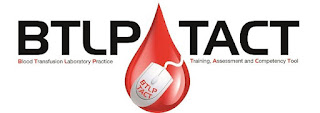I had a look at NEQAS digital morphology exercise 2106 DM on 16
November and was presented with:
“This is an image from a blood film prepared from a 67-year-old
female known to have mild anaemia and an enlarged spleen. At a routine clinic
follow up she was found to have a rising white cell count. You are asked your
opinion. This case has complex morphology so you may wish to look at our help
pages”
Well… the red cells were horrible. Anisopoikilocytosis with
echinocytes, tear drop cells, red cell fragments. Spherocytes and nucleated red
cells with polychromasia.
The white cells were equally yuk, with degenerate neutrophils,
myelocytes and blast cells. Odd-looking monocytes, smear cells and what I can
only call “bi-lobed strange things”. One might have been a Pelger-Huet
neutrophil. but the others looked lymphoid.
There were giant platelets and grey platelets and were a
couple of the odd things megakaryocytes?
As for the clinical condition… I would hazard a guess at
myelodysplasia considering transforming into leukaemia… but that’s just a
guess. Quite frankly if this appears down the microscope it gets referred
to the haematology consultant whose patient it already is.
The results were available to me today.
“This is a leucoerythroblastic picture with marked red cell
abnormalities and tear drops cells in a 67 year old female with
splenomegaly. The original diagnosis was
of JAK2 positive PRV but the features are much too abnormal to support this as
a sole diagnosis. In fact, at the time of this film the disease was
transforming to myelofibrosis (the presence of tear drop forms, early erythroid
progenitor cells, a bare megakaryocyte nucleus are suggestive of this
transformation). The primitive cells present on the film may be a reflection of
the advanced fibrosis, but in this case were found on bone marrow examination
to reflect an additional transformation to an acute leukaemia,”
Leukaemic transformation… I got that right.



 January 26, 2022
January 26, 2022  Join
Transfusion News Associate Editors Daniela Hermelin MD and Monica
Pagano MD on Twitter Space this Friday January 28 from 11:00-11:30 AM
EST for the first ever #Blooducation Baristas live event. Dr. Hermelin
and Dr. Pagano will be serving up piping hot Transfusion News along with
Evan Bloch MD, Claudia Cohn MD, and BJ Grossman MD.
Join
Transfusion News Associate Editors Daniela Hermelin MD and Monica
Pagano MD on Twitter Space this Friday January 28 from 11:00-11:30 AM
EST for the first ever #Blooducation Baristas live event. Dr. Hermelin
and Dr. Pagano will be serving up piping hot Transfusion News along with
Evan Bloch MD, Claudia Cohn MD, and BJ Grossman MD.  January 19, 2022
January 19, 2022  January 11, 2022
January 11, 2022 